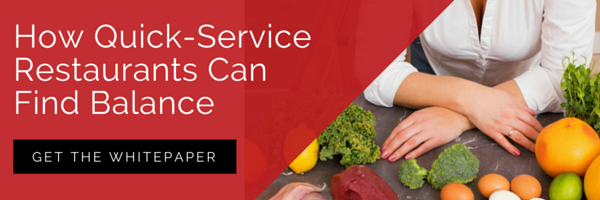
Local-sourcing. Organic. Free-from. Sustainable sourcing comes with a lot of buzzwords. And when it takes a significant investment of time and capital for a fast food brand to shift suppliers or alter sourcing practices, it’s critical that a brand knows a particular trend has staying power before launching any sustainability initiatives.
How do consumers define sustainability?
Sustainability, in any industry, is marked by complex dynamics and consumer sensibility, but there are two basic principles that seem to guide the ethical consumer’s food choices:
- The “wholesomeness” of a food (a term which describes an amorphous set of attributes that could include low sodium or fat content, pesticide-free, gluten-free, GMO-free and more).
- The environmental impact the production and transportation to market of a food (we’ll also include ethical considerations like labor rights and animal welfare in this category.
With these characteristics in mind, let’s explore how two of the most buzzed-about health trends stack up: organic and free-from.
Are consumers still interested in buying organic?
The short answer is “yes.” But perhaps not for long.
Consumers have come to read an “organic” label as kind of catchall term for a food or menu item that is wholesome and environmentally friendly. Not only is this food, in the mind of the consumer, more healthful and free from pesticides and additives, it is most certainly sustainably grown or raised.
This is not, asserts Forbes science contributor Henry I. Miller, necessarily the case.
Miller, a biomedical scientist and FDA drug regulator in his past life, notes that nearly all claims that have been made about organic food are either inconclusive or thoroughly debunked. Americans are, he writes, “getting both more and less than they bargained for,” paying up to 100 percent more for a product that fails offer the qualities they’re looking for.
- Not only are organic fruits and vegetables “on average no more nutritious than their far cheaper conventional counterparts,” organic foods can actually be more vulnerable to contamination “by pathogenic bacteria like coli or Salmonella.”
- Organic food is not produced without pesticides. Many exceptions are allowed by USDA guidelines and even “natural” substitutes can be highly toxic.
- Rather than minimizing ecological impact, there is evidence that organic farming has a (not insignificant) adverse effect on the environment. Independent agricultural consultant Dr. Steven Savage compared the 2014 USDA Organic Survey data with USDA-NASS statistics for total crop production and found that organic farming produced substantially lower yields while consuming more resources.
It would seem a case of three strikes and you’re out for the organic trend. But while consumers may have a fundamental misunderstanding of how organic food is produced and the actual health benefits it provides, the fact remains that consumers perceive organic food to be a better option. And, so far, they’ve been willing to shell out $39 billion a year for it.
But given the actual impact of organic farming, and the fact that consumers still want value from fast food meals, it is unlikely that a brand would be able to market a food on the strength of organic ingredients alone.
Does the “free-from” trend have staying power?
While the concept may have originally been coined to describe food that was free from one or all of the top eight food allergens, the term has evolved into a sweeping categorization of foods that are defined by what is not in them: gluten, GMOs, artificial ingredients, trans fats, etc.
While only a specific subset of Americans, just 37 percent of all consumers, are willing to pay a premium for food that’s specifically marketed as “free-from,” free-from foods are still strongly identified with healthfulness. In fact, according to Mintel’s 2015 Free-From Food Trends study, “43 percent of consumers agree that free-from foods are healthier than foods without a free-from claim, while another three in five believe the fewer ingredients a product has, the healthier it is (59 percent).”
But healthfulness isn’t the only factor driving purchases. Consumers also associate free-from foods with ethical and environmentally-friendly practices like free-range farming. Free-from is, essentially, a convergence of sustainability trends. And developments within the food industry itself highlight the significance of these particular elements of sustainability.
The gears of big food often grind slowly, and internal change is a slow, costly endeavor for a multinational brand. So when major brands like McDonald’s, Wendy’s, and Domino’s (and Pepsi, Kraft and Nestle on the food production side) start making commitments to remove additives and start sourcing cage-free eggs, it’s generally a strong sign that a trend has staying power.






